Dual-Band Band-Pass Filter with Fixed Low Band and Fluidically-Tunable High Band
Abstract
:1. Introduction
2. Frequency-Tunable Band-Pass Filter Design
3. Fabrication and Measurement
4. Conclusions
Acknowledgments
Author Contributions
Conflicts of Interest
References
- Kim, D. A High Performance Ibc-Hub Transceiver for Intra-Body Communication System. Microw. Opt. Technol. Lett. 2012, 54, 2781–2784. [Google Scholar]
- Soury, A.; Ngoya, E.; Rousset, J. Behavioral Modeling of RF and Microwave Circuit Blocs for Hierarchical Simulation of Modern Transceivers. In Proceedings of the 2005 IEEE MTT-S International Microwave Symposium Digest, Long Beach, CA, USA, 17 June 2005; pp. 975–978. [Google Scholar]
- Christina, P. Anti-Jamming Broadcast Communication Using Uncoordinated Spread Spectrum Techniques. IEEE J. Sel. Areas Commun. 2010, 28. [Google Scholar] [CrossRef]
- Jordan, R.L.; Huneycutt, B.L.; Werner, M. The SIR-C/X-SAR Synthetic Aperture Radar System. IEEE Trans. Geosci. Remote Sens. 1995, 33, 829–839. [Google Scholar] [CrossRef]
- Behavior, D.; Introduction, I. Bandwidth and Central Frequency Control on Tunable Bandpass Filter by Using MEMS Cantilevers. In Proceedings of the 2003 IEEE MTT-S International Microwave Symposium Digest, Philadelphia, PA, USA, 8–13 June 2003; pp. 523–526. [Google Scholar]
- Shim, Y.; Member, S.; Wu, Z.; Member, S. A High-Performance Continuously Tunable MEMS Bandpass Filter at 1 GHz. IEEE Trans. Microw. Theory Tech. 2012, 60, 2439–2447. [Google Scholar] [CrossRef]
- Chaudhary, G.; Jeong, Y.; Lim, J. Dual-Band Bandpass Filter with Independently Tunable Center Frequencies and Bandwidths. IEEE Trans. Microw. Theory Tech. 2013, 61, 107–116. [Google Scholar] [CrossRef]
- Danideh, A.; Sadeghzadeh, R.A. CPW-Fed Slot Antenna for Mimo System Applications. Indian J. Sci. Technol. 2013, 6, 3872–3875. [Google Scholar] [CrossRef]
- Huang, X.; Feng, Q.; Xiang, Q. Bandpass Filter with Tunable Bandwidth Using Quadruple-Mode Stub-Loaded Resonator. IEEE Microw. Wirel. Compon. Lett. 2012, 22, 176–178. [Google Scholar] [CrossRef]
- Pillans, B.; Malczewski, A.; Allison, R.; Brank, J. 6–15 GHz RF MEMS Tunable Filters. In Proceedings of the 2005 IEEE MTT-S International Microwave Symposium Digest, Long Beach, CA, USA, 17 June 2005; pp. 919–922. [Google Scholar]
- Brank, J.; Yao, J.; Eberly, M.; Malczewski, A.; Varian, K.; Goldsmith, C. RF MEMS-Based Tunable Filters. Int. J. RF Microw. Comput.-Aided Eng. 2001, 11, 276–284. [Google Scholar] [CrossRef]
- Entesari, K.; Rebeiz, G.M. A differential 4-bit 6.5–10-GHz RF MEMS Tunable Filter. IEEE Trans. Microw. Theory Tech. 2005, 53, 1103–1110. [Google Scholar] [CrossRef]
- Entesari, K.; Rebeiz, G.M. A 12–18-GHz three-pole RF MEMS Tunable Filter. IEEE Trans. Microw. Theory Tech. 2005, 53, 2566–2571. [Google Scholar] [CrossRef]
- Tsai, C.S.; Qiu, G.; Gao, H.; Li, G.P.; Yang, L.W.; Nikitov, S.A.; Gulyaev, Y. Tunable Wideband Microwave Band-Stop and Band-Pass Filters Using YIG/GGG-GaAs Layer Structures. IEEE Trans. Magn. 2005, 41, 3568–3570. [Google Scholar] [CrossRef]
- Murakami, Y.; Ohgihara, T.; Okamoto, T. A 0.5–4.0-GHz Tunable Bandpass Filter Using YIG Film Grown by LPE. IEEE Trans. Microw. Theory Tech. 1987, 35, 1192–1198. [Google Scholar] [CrossRef]
- Sanphuang, V.; Ghalichechian, N.; Nahar, N.K.; Volakis, J.L. Bandwidth Reconfigurable THz Filter Employing Phase-Change Material. In Proceedings of the 2015 IEEE International Symposium on Antennas and Propagation & USNC/URSI National Radio Science Meeting, Vancouver, BC, Canada, 19–24 July 2015; pp. 2289–2290. [Google Scholar]
- Goelden, F.; Gaebler, A.; Karabey, O.; Goebel, M.; Manabe, A.; Jakoby, R. Tunable Band-Pass Filter Based on Liquid Crystal. In Proceedings of the German Microwave Conference, Berlin, Germany, 15–17 March 2010; Volume 8, pp. 98–101. [Google Scholar]
- Guo, S.; Lei, B.J.; Hu, W.; Shiroma, W.A.; Ohta, A.T. A Tunable Low-Pass Filter Using a Liquid-Metal Reconfigurable Periodic Defected Ground Structure. In Proceedings of the 2012 IEEE MTT-S International Microwave Symposium Digest (MTT), Montreal, QC, Canada, 17–22 June 2012; pp. 1–3. [Google Scholar] [CrossRef]
- Gough, R.C.; Dang, J.H.; Morishita, A.M.; Ohta, A.T.; Shiroma, W.A. Frequency-Tunable Slot Antenna Using Continuous Electrowetting of Liquid Metal. In Proceedings of the 2014 IEEE MTT-S International Microwave Symposium (IMS), Tampa, FL, USA, 1–6 June 2014; pp. 1–3. [Google Scholar] [CrossRef]
- Traille, A.; Bouaziz, S.; Pinon, S.; Pons, P.; Aubert, H.; Boukabache, A. A Wireless Passive RCS-Based Temperature Sensor using Liquid Metal and Microfluidics Technologies. In Proceedings of the 2011 41st European Microwave Conference (EuMC), Manchester, UK, 10–13 Octobor 2011; pp. 45–48. [Google Scholar]
- Morishita, A.M.; Dang, J.H.; Gough, R.C.; Ohta, A.T.; Shiroma, W.A. A Tunable Amplifier Using Reconfigurable Liquid-Metal Double-Stub Tuners. In Proceedings of the 2015 Texas Symposium on Wireless and Microwave Circuits and Systems (WMCS), Waco, TX, USA, 23–24 April 2015; pp. 4–7. [Google Scholar] [CrossRef]
- Morishita, A.M.; Gough, R.C.; Dang, J.H.; Ohta, A.T.; Shiroma, W.A. A Liquid-Metal Reconfigurable Log-Periodic Balun. In Proceedings of the 2014 IEEE MTT-S International Microwave Symposium (IMS), Tampa, FL, USA, 1–6 June 2014; pp. 8–10. [Google Scholar] [CrossRef]
- Khan, M.R.; Hayes, G.J.; Zhang, S.; Dickey, M.D.; Lazzi, G. A Pressure Responsive Fluidic Microstrip Open Stub Resonator Using a Liquid Metal Alloy. IEEE Microw. Wirel. Compon. Lett. 2012, 22, 577–579. [Google Scholar] [CrossRef]
- Mumcu, G.; Dey, A.; Palomo, T. Frequency-Agile Bandpass Filters Using Liquid Metal Tunable Broadside Coupled Split Ring Resonators. IEEE Microw. Wirel. Compon. Lett. 2013, 23, 187–189. [Google Scholar] [CrossRef]
- Eom, S.; Memon, M.U.; Lim, S. Frequency-Switchable Microfluidic CSRR-Loaded QMSIW Band-Pass Filter Using a Liquid Metal Alloy. Sensors 2017, 17, 699. [Google Scholar] [CrossRef] [PubMed]
- Sun, J.-S.; Fang, H.-S.; Lin, P.-Y.; Chuang, C.-S. Triple-band MIMO Antenna for Mobile Wireless Applications. IEEE Antennas Wirel. Propag. Lett. 2016, 15, 500–503. [Google Scholar] [CrossRef]
- Hong, J.S.; Lancaster, M.J. Canonical Microstrip Filter Using Square Open-Loop Resonators. Electron. Lett. 1995, 31, 2020–2022. [Google Scholar] [CrossRef]
- Resonators, S.; Zhang, X.Y.; Member, S.; Chen, J.; Member, S.; Xue, Q.; Member, S. Dual-Band Bandpass Filters Using. IEEE Microw. Wirel. Compon. Lett. 2007, 17, 583–585. [Google Scholar]
- Ling, K.; Kim, H.; Yoo, M.; Lim, S. Frequency-Switchable Metamaterial Absorber Injecting Eutectic Gallium-Indium (EGaIn) Liquid Metal Alloy. Sensors 2015, 15, 28154–28165. [Google Scholar] [CrossRef] [PubMed]
- Dickey, M.D.; Chiechi, R.C.; Larsen, R.J.; Weiss, E.A.; Weitz, D.A.; Whitesides, G.M. Eutectic Gallium–Indium (Egain): A Liquid Metal Alloy for the Formation of Stable Structures in Microchannels at Room Temperature. Adv. Funct. Mater. 2008, 18, 1097–1104. [Google Scholar] [CrossRef]
- Lee, J.; Bang, J.; Choi, J. Realistic Head Phantom for Evaluation of Brain Stroke Localization Methods Using 3D Printer. J. Electromagn. Eng. Sci. 2016, 16, 254–258. [Google Scholar] [CrossRef]
- Kwon, K.-A.; Kim, H.-K.; Yun, S.-W. Design of Dual-Band Bandpass Filters for Congnitivie Radio Application of TVWS Band. J. Electromagn. Eng. Sci. 2016, 16, 19–23. [Google Scholar] [CrossRef]
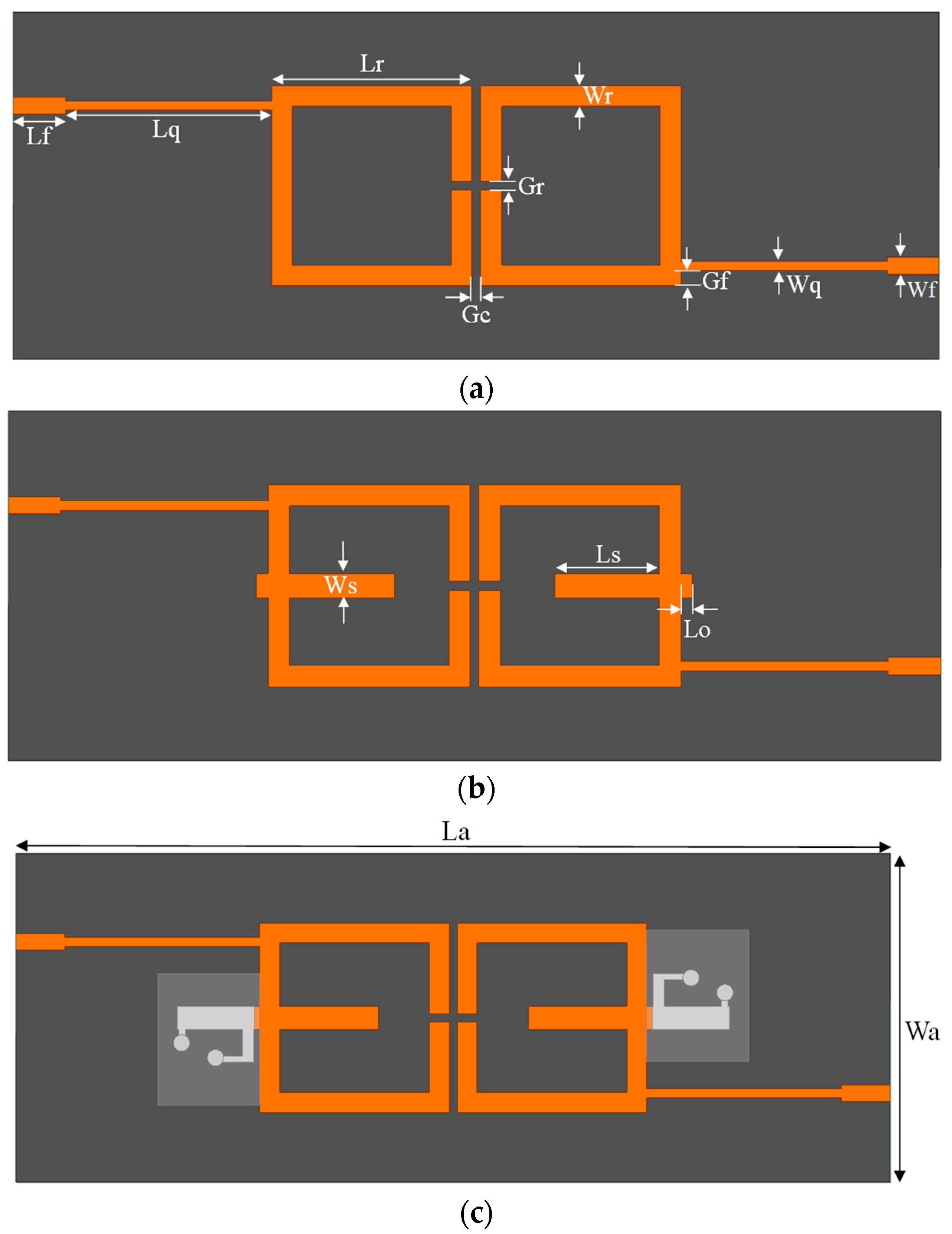
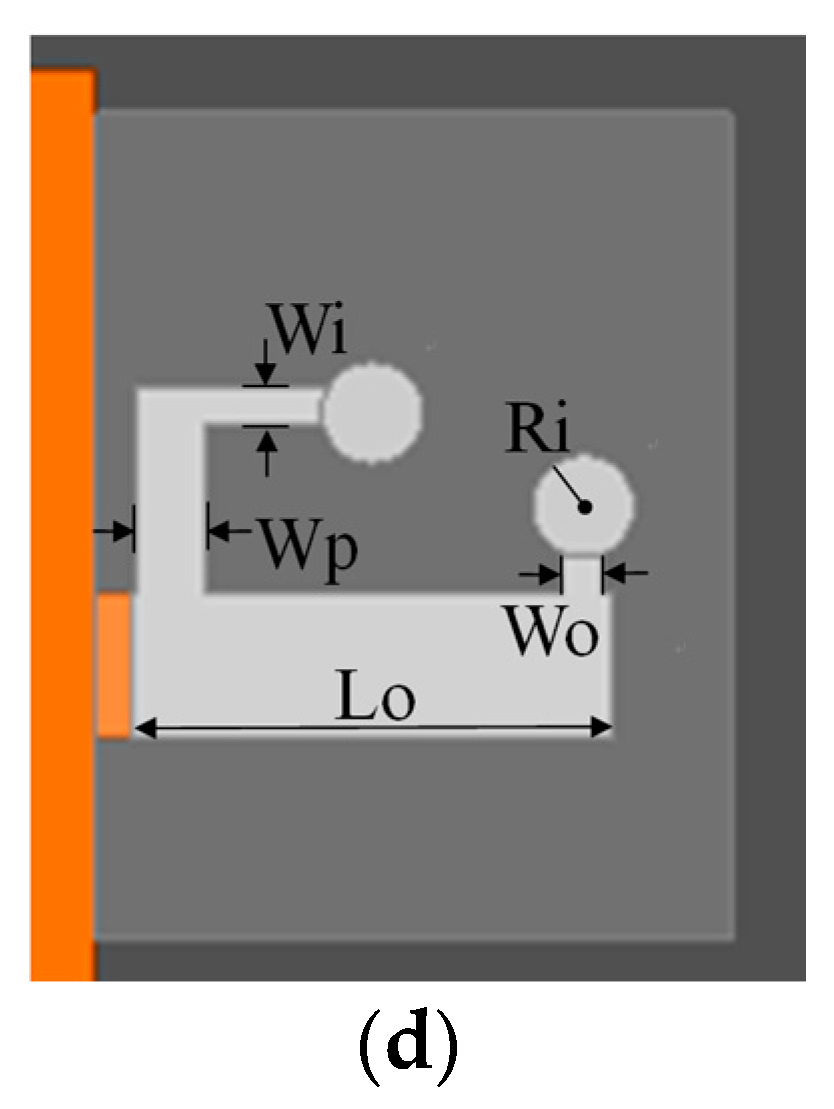

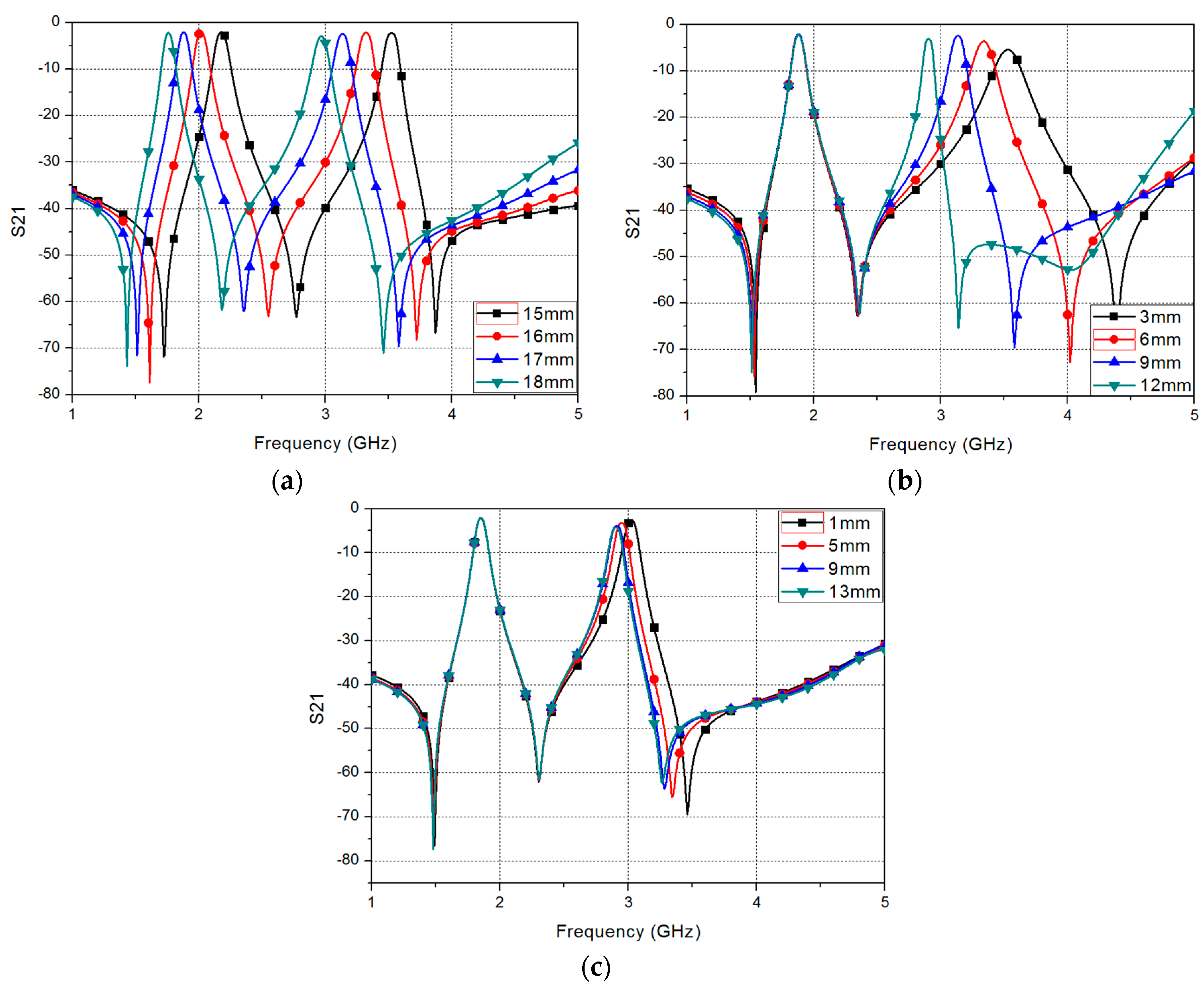
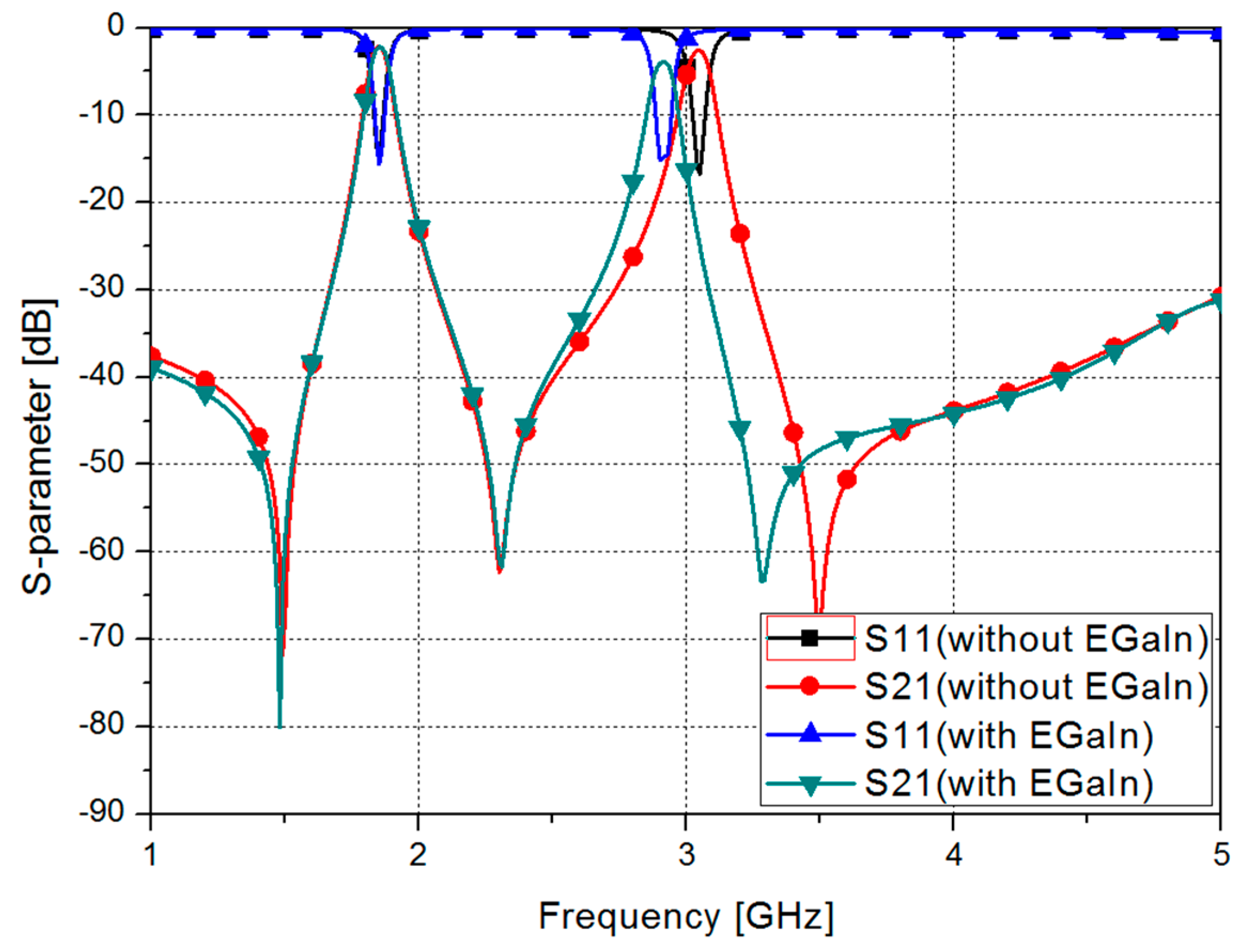
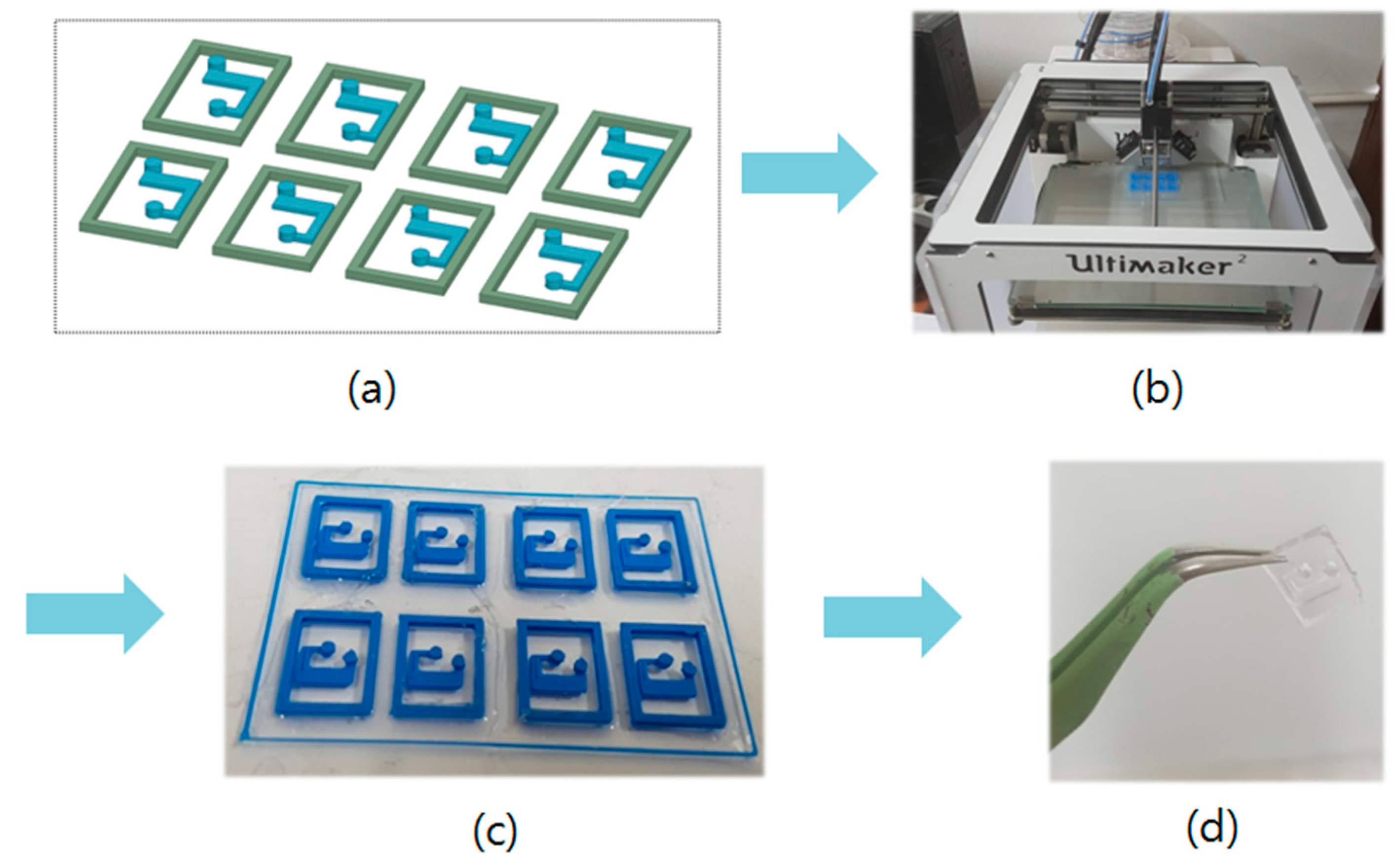
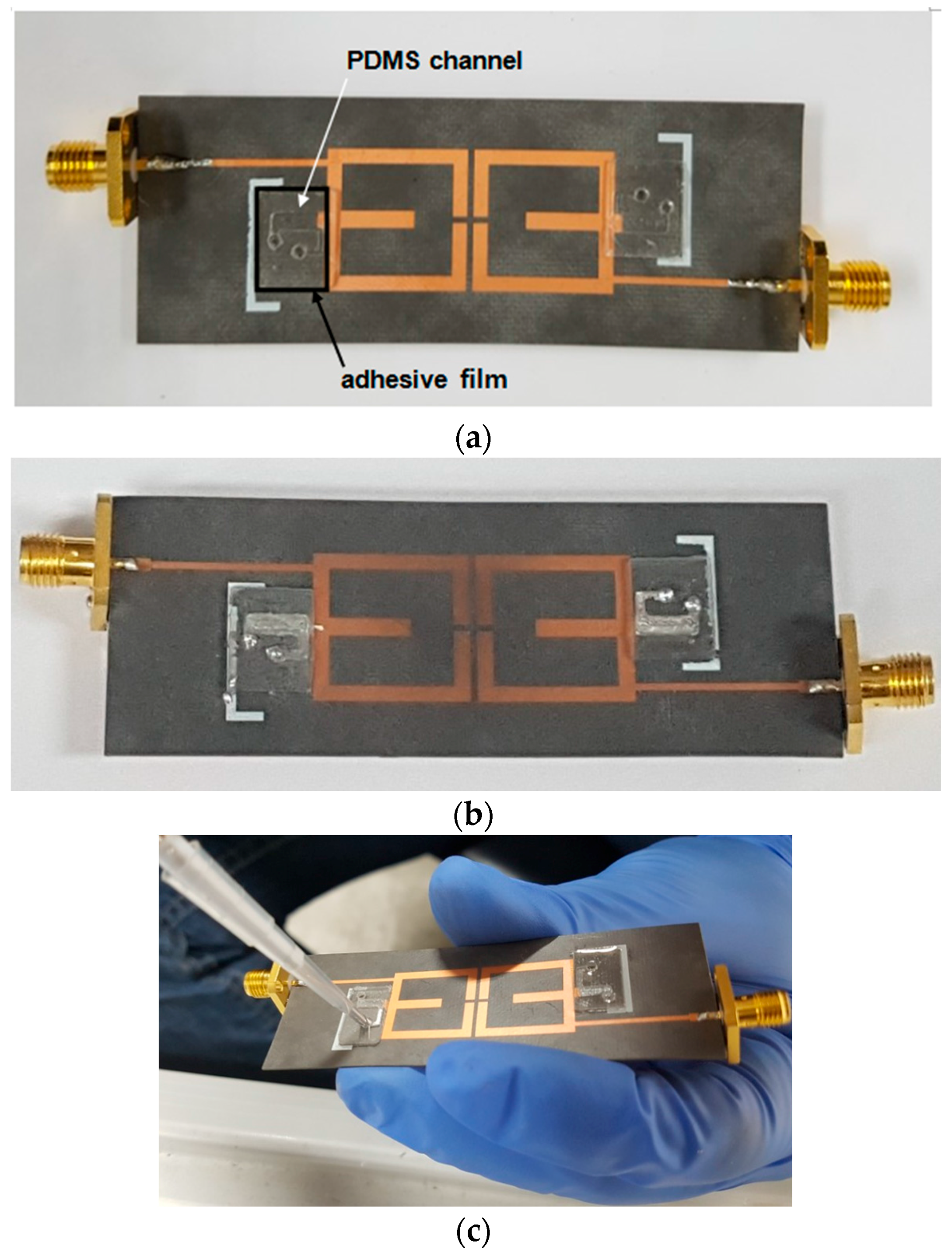
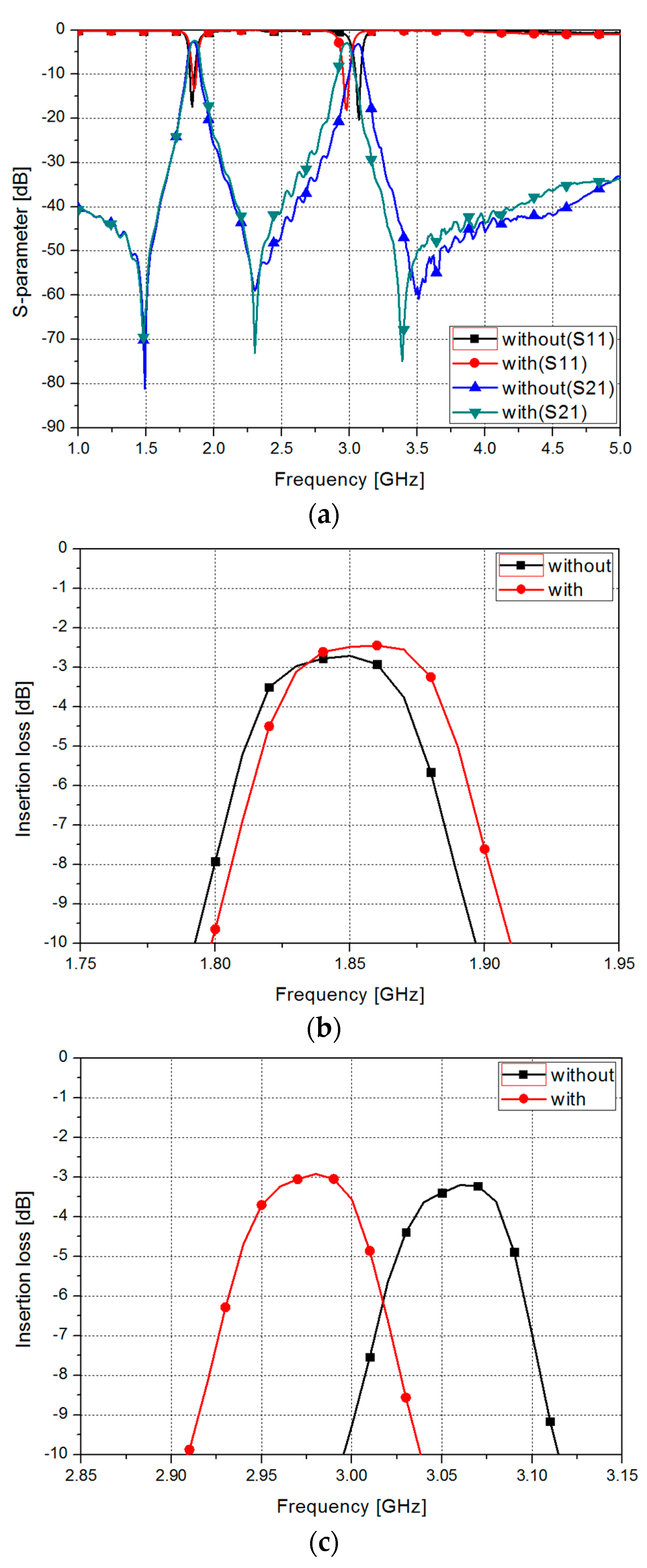
| Without EGaIn | With EGaIn | ||||
|---|---|---|---|---|---|
| Simulation | Measurement | Simulation | Measurement | ||
| Odd Mode | Resonant Freuqnecy (GHz) | 1.85 | 1.85 | 1.85 | 1.86 |
| Insertion Loss (dB) | 2.15 | 2.72 | 2.17 | 2.45 | |
| Fractional Bandwidth (%) | 4.32 | 4.34 | 4.32 | 4.3 | |
| Even Mode | Resonant Freuqnecy (GHz) | 3.05 | 3.06 | 2.9 | 2.98 |
| Insertion Loss (dB) | 2.57 | 3.21 | 3.9 | 2.93 | |
| Fractional Bandwidth (%) | 2.75 | 2.94 | 2.96 | 2.95 | |
| [18] | [24] | [25] | Proposed Work | |
|---|---|---|---|---|
| Filter type | Lowpass | Band-pass | Band-pass | Dual Band-pass |
| Insertion Loss (dB) | N/A | <3 | <1.5 | <2.72, <3.21 |
| Bandwidth (%) | N/A | 5 | 9.38 | 4.34, 2.95 |
| Tuning Range (%) | 38 | 25.3 | 14 | 2.7 |
| Number of band | Single Band | Single Band | Signle Band | Dual Band |
© 2017 by the authors. Licensee MDPI, Basel, Switzerland. This article is an open access article distributed under the terms and conditions of the Creative Commons Attribution (CC BY) license (http://creativecommons.org/licenses/by/4.0/).
Share and Cite
Park, E.; Lim, D.; Lim, S. Dual-Band Band-Pass Filter with Fixed Low Band and Fluidically-Tunable High Band. Sensors 2017, 17, 1884. https://doi.org/10.3390/s17081884
Park E, Lim D, Lim S. Dual-Band Band-Pass Filter with Fixed Low Band and Fluidically-Tunable High Band. Sensors. 2017; 17(8):1884. https://doi.org/10.3390/s17081884
Chicago/Turabian StylePark, Eiyong, Daecheon Lim, and Sungjoon Lim. 2017. "Dual-Band Band-Pass Filter with Fixed Low Band and Fluidically-Tunable High Band" Sensors 17, no. 8: 1884. https://doi.org/10.3390/s17081884





